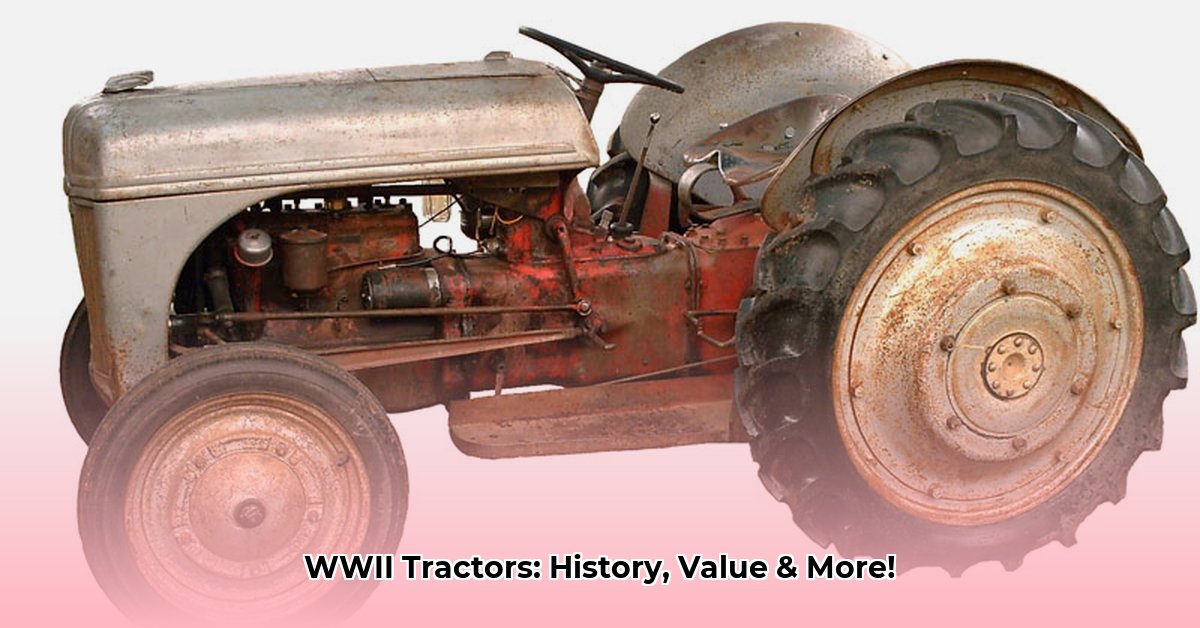
1941 Tractors: American Workhorses of War and Peace
Imagine the American heartland in 1941. The specter of World War II loomed large, yet the nation's farms hummed with activity, fueled by powerful machines like the John Deere Model L/LA and the even more robust Model H tractors. These weren't simply farm implements; they were the backbone of America’s food supply, ensuring a nation at war remained fed. These tractors, symbols of agricultural prowess, quietly contributed to a monumental global conflict in unexpected ways. But their story extends far beyond wartime service – they've become sought-after collector's items, representing a tangible link to a pivotal era in American history. How did these machines contribute to the war effort, and what makes them so desirable today? For more information on finding used tractors, check out this useful resource.
The Model L/LA and Model H were impressive feats of engineering. The Model L/LA, while slightly smaller, was a tireless workhorse. The Model H, however, was truly a beast – a machine capable of handling the immense demands of pre-war American agriculture. Their powerful gasoline engines (Model L/LA: approximately 14-17 HP; Model H: approximately 20 HP), along with their robust manual transmissions, enabled them to plow fields and harvest crops with unwavering efficiency. Their significant weight (Model L/LA: roughly 3000 pounds; Model H: roughly 4000 pounds) provided stability and traction, even in challenging conditions. These weren't delicate machines; they were built for a lifetime of hard labor. But their contributions went beyond the simple cultivation of fields. Did you know their impact was far-reaching?
"These tractors weren't just about the bushels of wheat or acres of corn; they were symbols of American resilience and the enduring spirit of the nation," says Dr. Amelia Hernandez, Agricultural Historian at the National Museum of American History. This dual role—providing for the nation's nutritional needs while also contributing to wartime efforts—highlights the powerful importance of these machines. Their contributions were essential in supporting both those fighting overseas and the families waiting at home. How did this critical food production impact the war effort?
The ingenious adaptability of the Model H is particularly noteworthy. Many farmers repurposed their tractors as makeshift observation posts, raising them to higher ground to spot enemy aircraft. This innovative use of readily available technology provided a crucial early warning system. Imagine the scene: a farmer, usually focused on tilling the soil, now scanning the skies, transformed into a vital part of the national defense system. This demonstrates the ingenuity and resourcefulness of the American people during a challenging time. This dual role emphasizes the significant impact these machines had on the war effort, going beyond their primary agricultural function. But how did this adaptability affect the availability of these tractors today?
Even after the war, these tractors continued to serve farmers for decades, becoming nostalgic symbols of a simpler time. Many are still operational today, a testament to their robust construction and the care of their owners. Their enduring legacy extends beyond their functional utility; they've become highly sought-after collector's items. Owning one is acquiring a tangible piece of American history – a connection to a generation that overcame immense hardships.
Restoring a WWII-Era John Deere Model H: A Labor of Love
Preserving these historical machines is a challenging but rewarding undertaking. Restoring a 1941 tractor is a labor of love, demanding specialized knowledge, significant time investment, and considerable financial resources. However, for enthusiasts, the effort is immensely worthwhile. It's a journey into the past, a chance to connect with history, and a tribute to the enduring legacy of these remarkable machines. But where does one even begin?
Finding comprehensive restoration guides can be a significant hurdle. While Patrick Browning's John Deere Model H Restoration Guide once existed in print, it's now primarily available digitally. Naomi Lindstrom currently offers this digital version. However, websites such as Yesterday's Tractors provide a wealth of information, including detailed restoration guides, troubleshooting tips, and wiring diagrams—an invaluable resource for those embarking on such a project. And this is not just a solo effort.
"The Yesterday's Tractors community is invaluable," notes Mark Olsen, a seasoned vintage tractor restorer from Iowa. "The collective knowledge and shared experience are essential for overcoming the challenges of restoration." This community highlights the collaborative spirit needed to preserve these pieces of history. But what are the practical steps involved?
Here's a breakdown of the restoration process:
- Assessment: Begin with a comprehensive examination of the tractor, identifying areas requiring repair or replacement.
- Parts Sourcing: This can be the most challenging step. Original parts are rare, requiring searches through online forums, specialized dealers, and even scrap yards.
- Mechanical Restoration: Repair or replace worn components, guided by resources such as Browning's guide and the expertise of the community.
- Reassembly: Proceed methodically and precisely, following service manuals to ensure proper function.
- Finishing Touches: Once operational, restore the paint and decals to complete the restoration, transforming it into a show-stopper.
However, the digital nature of crucial resources presents a preservation challenge in itself. The longevity of digital formats is uncertain, making digital archiving and open-source knowledge-sharing vital for ensuring future generations can continue this legacy.
The Allure of Owning a Piece of History
The rewards of restoring a WWII-era John Deere tractor extend far beyond monetary value. It's about the connection to history, the satisfaction of bringing a piece of the past back to life, and the sense of accomplishment in preserving a tangible link to a pivotal moment in American history. The journey itself, with its challenges and triumphs, adds to the uniqueness and value of owning one of these unique machines. Are you ready to unearth a piece of this legacy?
Yesterday's Tractors Website - John Deere “H” Restoration Site Updated 🌐